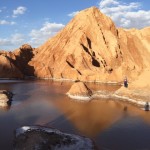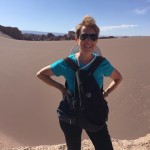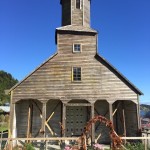Chile is not on most people’s vacation radar, but the South American country has occupied a line on Kitty Morse’s dream-trip list since she was a grade-schooler in Casablanca, Morocco.

“My geography classes made me dream of exotic locations like Antofagasta, Valparaiso and the Atacama Desert, even though the Sahara dunes were only a day’s drive from my school,” explains the longtime Vista resident. “Besides, I’ve always wanted to see my hometown’s namesake in Chile — Valle de Casablanca,” – heart of the country’s wine region.

According to a Chilean tourism organization, nearly 187,000 U.S. residents traveled to Chile in 2015. (Total visitors number about 3.8 million; most are from neighboring South American countries.)
Morse was born in Casablanca of a French mother and British father, and grew up speaking English and French equally. She immigrated to the United States at age 17, and is the author of 11 cookbooks. She was surprised that, during her two-week stay in Chile, “practically every tourist I encountered was a native French speaker. There was hardly a gringo in sight.”

Once Morse decided to go, she cashed in her frequent flier miles, worked with a “delightful” travel agent in Santiago (via the internet), and decided to give Airbnb a try in Santiago.
“I had success on all counts,” she says.
Morse’s itinerary included six days in Santiago, four days in the Atacama Desert in the north, and five days in Northern Patagonia in the south.
“I decided to forego the glaciers in Patagonia, since I had seen some in Alaska last year,” she explains. “I flew instead to the Region de Los Lagos Andinos (the Lake Region) and spent a day cruising Lago de Todos Santos, the first in a series of seven lakes that eventually leads to Bariloche, Argentina.”

Photo opportunities were at every turn: the pink flamingos, herds of wild vicuñas, steaming geysers and colorful canyons of the Atacama Desert; the palafitos (homes on stilts) and the Castro market on the island of Chiloe; the spectacular Volcan Osorno (volcano) in the Lake Region; and the two-hour cruise to Peulla at the far end of Todos Santos Lake.

And though Morse has a passion for ethnic foods, she didn’t expect to find gourmet offerings in Chile. Surprisingly, though, she found excellent cuisine in several places. On the island of Chiloe, “the seafood is outstanding,” she recounts. “And there was mouth-watering Tablao Patagónico loaded with seafood, sausages and cheeses at La Gringa restaurant in Puerto Varas, and salmon ceviche purchased from a food truck kept me happy until it came time to take the ferry to the Island of Chiloe.”
And Morse finally visited Valle de Casablanca (Valley of Casablanca, outside Santiago), which had been on her wish list for many years.
“Friends took me to the gorgeous Casas del Bosque winery where I sampled the famed Carménère wine, which has its origins in the Médoc region of Bordeaux,” she says. “It was thought to be extinct, but was rediscovered in Chile in 1994.”

In the end, Morse’s adventures in Chile were the result of a mix of good planning and serendipity.

“Sometimes I was traveling by the seat of my pants. My Morocco tours were much more organized.” (For many years, Morse led groups on sightseeing and culinary tours in Morocco.)
It’s been about three months since Morse’ return to Vista, but she still relives her trip with gusto.
“Northern Patagonia and Atacama Desert still sound so exotic that I can hardly believe I was actually there,” she confesses.

E’Louise Ondash is a freelance writer living in North County. Tell her about your travels at [email protected]


